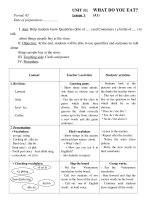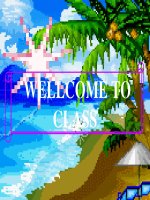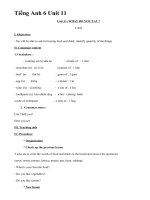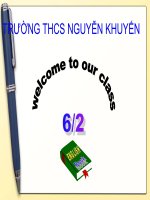ANH 6 - UNIT 11
Bạn đang xem bản rút gọn của tài liệu. Xem và tải ngay bản đầy đủ của tài liệu tại đây (113.61 KB, 11 trang )
UNIT 11:
Period: 65
Date of preparation:……………….
Lesson 1:
WHAT DO YOU EAT?
(A1)
I. Aim: Help students know Quantifies (kilo of …… ) and Containers ( a bottle of …… ) to
talk
about things people buy at the store.
II. Objective: At the end, students will be able to use quantifies and containes to talk
about
things people buy at the store.
III. Teaching aids: Cards and poster.
IV. Procedure:
Content
Teacher’s activities
Guessing game.
- Show them some drinks. Ask
them to choose one of them.
- Get the rest of the class to
guess which drink they
choose. The first student
guesses the drink correctly
comes up to the front, chooses
a new words and the game
continues.
1. Revision:
- Lemond
- Soda
- Iced - tea
- Coffee
2 .Presentation:
+Vocabulary:
- an egg : trứng.
- Cooking oil : dầu ăn.
- Beef (unc) : thịt bò .
- Soap (unc) : cà phê.
- Tooth past (unc) : kem đánh răng.
- a chocolate : sô cô la
+ Checking vocabulary:
sô cô la
xà phòng
kem đánh răng
thịt bò
dầu ăn
grams of
M
a kilo
abar of
a can of
12
Camay
a box of
a packet of 7up
200g
a dozen of
Tea a tube of
p/s
a bottle of
1kg
3. Practice:
- a bottle / cooking oil
- a packet / tea
- a box / chocolates
- a kilo / rice
- 200 gram / beef
- a dozen / eggs
Students’ activities
- Students look at the
pictures and choose one of
the drinks the teacher shows
- The rest of the class asks
him or her question to find
which drink he or she
chooses.
* Does he / she like ?
* Yes, he / she does.
* No,he / she doesn’t.
Elicit vocabulary
- Show things in the picture
and read their names aloud.
+ What’s this?
+ How can you say it in
Enghlish?
- Aks students to repeat.
- Listen to the teacher.
- Repeat after the teacher.
- Notice the main stress
pattern.
- Write the new words in
their notebooks.
Slap the board
- Put the
Vietnamese
translation on the board.
- Call two students of two
teams to the front of the class.
- Call out one of English
words in loud voice.
Group works.
- Say the
Vietnamese
translation .
- Run forward and slap the
correct words on the board.
- Continue until students
have slapped all the words.
Matching
- Put the pictures and English
words on the board.
-Ask students to match English
words with the pictures .
- Ask students to work in
teams.
Group works.
- Lookl at the board.
- Listen to the teacher.
- Work in teams.
- Come to the board and
match English words with
the pictures.
Word cue drill
- Look at the cues.
- Listen to the teacher.
- Repeat it chorally and then
- Run through the cues.
- Hold up the first cues and individually.
- Make the sentence for
say the model sentences.
themselves.
- Can I help you?
- Yes, I’d like 200gram of beef - Practice in pairs.
- Correct their mistakes.
- Some pairs practice in
front.
Week: 23
Period: 67
Date of preparation:……………….
UNIT 11:
WHAT DO YOU EAT?
Lesson 3:
AT THE STORE (A3 – A4)
I. Aim: Help students develop their listening skill.
II. Objective: At the end, students will be able to listen specific information about
qualities
for food shopping.
III. Teaching aids: Cassette and textbook.
IV. Procedure:
Content
1.Warm up:
- beef
- egg
- dozen
- oil
- rice
Teacher’s activities
- bottle
- tea
- water
- gram
- chocolate
2 .Pre listening:
+Vocabulary:
- to need : caàn.
- How much / How many : bao nhieâu.
- Can I hepl you? : Tôi có thể giúp gì
cho bạn ?
- Half (a kilo) : 1/2
- a cookie : banh qui gai.
* Checking vocabulary:
A2, page 112
Salesgirl: Can I hepl you?
Ba: Yes, I’d like some (1) ___ , please.
Salesgirl: How much do you want?
Ba: (2) ______ grams , please.
Salesgirl: Is there any things else ?
Ba: Yes, I need some (3)___ .
Salesgirl: How many do you want?
Ba: (4) ______ , please.
3. While listening:
1. beef
2. 200
3. eggs
4. a dozen
Comprehension question
a. At the store d. a dozen
b. beef
c. 200
A3 on page 117
+ Phuong - a tube of toothpaste.
+ Ly - a bar of soap and
- a box of chocolates
+ Mai - a can of soda
Students’ activities
Bingo
- Put the table on the board.
-Ask students to choose any
five words and copy them into
their books.
- Let students listen to the
cassette and correct.
- Read the words in the
table.
- Listen to the teacher.
- Choose any five words.
- Put ticks next to the words
that they listen to.
- Shouts “Bingo”.
Elicit vocabulary
•
Transltion
•
Situation
•
Situation
- Listen to the teacher.
- Repeat after the teacher.
- Notice the main stress
pattern.
- Write the new words in
their notebooks.
•
Visual
•
Translation
Rub out and remember
-Point to the Vietnamese
translations and rub out
English words.
- Get students to call the
English words.
Predict dialogue
- Set the scene:
+ Where is Ba?
+ What does he want?
+ How much / many ……?
- Put the dialogue on the
board. Some of the words are
missing.
- Ask students to guess what
the missing words are.
- Students repeat chorally
and remember all the
English words.
- Call the English words and
write the English words if
there is time.
- Listen to the teacher.
-Answer
the
teacher’s
questoins.
- Read the dialogue.
- Guess what the missing
words are.
- Students give their
prediction.
- Get students to listen to the - Listen to the tape two
tape 2 times .
times.
- Correct their prediction.
- Check their prediction.
- Ask students to listen the
tape again, then answer the
questions.
Matching
- Let them listen to the
cassette and find out things
that people want to buy.
- Let some of students answer
and ask the whole class tvo
listen to again and check their
- Listen the tape again .
Then answer the questions.
- Listen to the cassette and
find out things that people
want to buy.
- Some of students answer
and ask the whole class tvo
listen to again and check
Week: 23
Period: 68
Date of preparation:……………….
UNIT 11:
WHAT DO YOU EAT?
Lesson 2:
AT THE STORE (A2)
I. Aim: Help students practice “How much / how many” with “want” or “need”.
II. Objective: At the end, students will be able to use“How much / how many” to talk
about
quanlities for shopping.
III. Teaching aids: Poster and textbook.
IV. Procedure:
Time
Content
1. Revision:
How much
Meat
Milk
Bread
Beef
Rice
chiken
How many
oranges
bananas
corrots
chocolates
eggs
apples
2 .Presentation: A2 on page 116
- I’d like some beef.
- How much beef do you want?
- I need some eggs.
- How many eggs do you want?
- How much +(unc.N)+do/does+S+V?
- How many+(plu.N)+ do/does+S+V?
- S + V(want / need) + Qualities(S.l)
- Cần /muốn bao nhiêu.
- Hỏi về số lượng.
3. Practice:
Shopping list
300g beef
1 kg rice
500g beans
6 apples
1 dozen eggs
2 boottles milk
3 packet noodles
Teacher’s activities
Dictation lists
- Write the lists “How much”
and “How many” on the
board.
- Read: oranges, meat,
bananas, milk, oil, bread,
carrots, chocolates, beef,………
- Feedback.
Customer
Can / you ?
How much?
there / else ?
How many ?
meat
300 gram
need / pototoes
2 kilos.
5.Homework:
- How much / how many…… ?
- Unit 11: What do you eat? – AT
THE CANTEEN - Lesson 4 : B1,4.
- Copy the lists in their
notebook.
- Listen to the teacher.
- Put the words in correct
colums.
- Show their answers.
- Students read the dialogue
in A2 on page 116 again .
Presentation dialogue
- Make the questions to
- Show students the dialogue.
- Ask students to isolate the isolate the model sentence:
model sentence by making -How much beef do you
want?
questions (Answer given)
-How many eggs do you
+ I’d like some beef.
want?
+ I need some eggs.
-
Board drill
Put a shopping list on
the board.
Run
through
the
phrazes.
Say
the
model
sentences.
Do the same for the
second cue.
Correct their mistakes.
4.Further practice:
Shopkeeper
Students’ activities
Mapped dialogue
- Put the dialogue on the board
which is only words. The
words are cues.
- Model the dialogue.
- Run through the cues like a
drill with the whole class.
- Read the shopping
list.
Read the phrazes.
- Repaet
-
after the
teacher (The fisrt cue
then the second cue).
Make the sentences
for themselves.
- Look at the board and
listen to the teacher.
- Repeat after the teacher.
- Practice the dialogue in
pair .
- Some pairs practice in
front.
- Rewrite the dialogue .
- Ask students to learn how to - Take notes and memorize
talk about quanlities for - Do
as the teacher
shopping.
suggests.
- Have them prepare Unit 11 L 4 :(B1,4:What would you like
UNIT 11:
Period: 69
Date of preparation:……………….
Lesson 4:
WHAT DO YOU EAT?
AT THE CANTEEN (B1,4)
I. Aim: Help students practice offers and requests for food and drink, using “ a, an and
some”.
II. Objective: At the end, students might practice offers and requests more fluently.
III. Teaching aids: Cassette and textbook.
IV. Procedure:
Content
Teacher’s activities
1. Warm up:
rice
noodles
beef
chicken
fish
vegetables
oranges
bananas
orange
juice
milk
soda
water
2 .Presentation: B3 on page 119
- What would you like for breakfast?
- I’d like some milk and a banana.
- What would you like for lunch?
- I’d like some meat, vegetables and an
orange.
- What would you like for + N(meal)?
- I’d like some / a / an………………………
- Baïn dùng gì cho bữa ăn ……………?.
- Tôi muốn ……………………….
3. Practice:
- rice
- soda
- noodles
- meat
- bananas
- fish
- milk
- vegetables
4.Further practice:
What would you like for….?
break- lunch
dinner
fast
milk,
………… …………
bread .. ………… …………
………… ………… …………
………… ………… …………
………… ………… …………
………… ………… …………
5.Homework:
Name
- Lan
…………
…………
…………
…………
…………
Students’ activities
Kim’s game
- Have students look at the
picture of food / drink in B1 on
page119 and try to remember
as many words as possible.
- Divide class into two groups.
- Put away the picture and ask
students to go to the board and
write the words they’ve seen
from memory.
- The group having the most
right English words is the
winner.
- Look at the picture of food
and drink (B1,Page 119) in
20 seconds and try to
remember as many words as
possible.
- Work in groups.
- Put away the picture and
ask students to go to the
board and write things
they’ve seen from memory.
- Congratulate.
Presentation pictures
- Show students the picture .
- Say the model sentences:
+ What would you like for
breakfast?
+ I’d like some milk.
+ What would you like for
lunch?
+ I’d like some rice , fish and a
banana .
- Students read the dialogue
in A2 on page 116 again .
- Make the questions to
isolate the model sentence:
-How much beef do you
want?
-How many eggs do you
want?
Picture drill
- Run through the pictures.
- Hold up the first picture and
say the model sentences:
+What would you like for
lunch?
+ I’d like some meat, rice and
vegetables.
- Do the same for the seccond
picture.
- Correct their mistakes.
Survey
- Get students to fill in their
real names and what time they
do the following things.
- Get them to practice in pairs:
+ What would you like for …?
+ I ‘d like some / a / an ……….
- Feedback.
- Look at the pictures.
- Listen to the teacher.
- Repeat it chorally and then
individually.
- Make the sentence for
themselves.
- Practice in pairs.
- Some pairs practice in
front.
-
Ask
students
to
- Fill in their real names
and what time they do the
following things.
- Practice in pairs.
- Tell the teacher what they
have asked their partner,
e.g.“Lan would like some
milk and bread for her
breakfast………
learn - Take notes and memorize
UNIT 11:
Period: 70
Date of pre
Lesson 5:
WHAT DO YOU EAT?
AT THE CANTEEN (B2, 3,5-6)
I. Aim: Talking about prices for food and drink with “ How much ………………”.
II. Objective: At the end, students might use “ How much …………… “ to talk about prices.
III. Teaching aids: Poster and textbook.
IV. Procedure:
Content
1.Revision:
a can of soda, a bottle of water, some rice,
a glass of orange juice, some meat, some
oranges, some fish, some vegetables, some
chicken, a bowl of noodles.
Teacher’s activities
Students’ activities
Bingo
- Put the table on the board.
-Ask students to choose any
five things and copy them into
their books.
- Read out the words in any
order.
-Look at the board.
- Listen to the teacher.
- Choose any five things.
- Put ticks next to the things
that they listen to.
- Shouts “Bingo”.
2 .Presentation:
+Vocabulary:
- Fifty : 50.
- a hundred (Two hundred) : 100 (200)
- a thousand(Two thousand): 1000 /
2000
- seven thousand five hundred : 7.500.
+ Checking vocabulary:
2000
7.500
100
1000
200
+ Target language:
How much is / are…? It’s / they’re
2,500ñ
- a fried rice
3,000ñ
- a bowl of noodles
1,500ñ
- a sandwich
500ñ
- a cake
1,800ñ
- an orange juice
1,000ñ
- a lemon juice
2,000ñ
- an ice-cream
- How much + be + S ?
- It / they + be + price
- Giaù bao nhiêu?
- Hỏi về giá cả.
3. Practice:
How much is / are…?
- a fried rice
- a bowl of noodles
- a sandwich
- a cake
- an orange juice
- a lemon juice
It’s / they’re
2,500đ
3,000đ
1,500đ
500đ
1,800đ
1,000đ
Elicit vocabulary
•
Visual
•
//
•
//
•
//
Slap the board
- Put the
numbers on the
board.
- Call two students of two
teams to the front of the class.
- Call out one of numbers in
English in loud voice.
Presentation text
- Ask students to read a menu
in A5 on page 120 then anwer
some questions about prices to
isolate the model sentence:
+ How much is a fried rice?
+ How much is a cake?
+ How much is a sandwich?
- Let students copy the notes
in their notebooks and
memorize.
-
Board drill
Put a menu on the
board.
Run
through
the
phrazes.
Say
the
model
sentences.
Do the same for the
second cue.
- Listen to the teacher.
- Repeat after the teacher.
- Notice the main stress
pattern.
- Write the new words in
their notebooks.
Group works.
- Say the
numbers in
English .
- Run forward and slap the
correct numbers on the
board.
- Students have slapped all
the numbers.
- Students read the menu.
- Answer the questions about
prices to isolate the model
sentence:
+ It’s 2,500 ñ.
+ It’s 500 ñ.
+ It’s 1,500 ñ.
- Copy the notes in the
notebooks and memorize.
- Read the shopping
list.
Read the phrazes.
- Repeat
-
after the
teacher (The fisrt cue
then the second cue).
Make the sentences
for themselves.
UNIT 11:
Period: 71 Lesson 6:
Date of pre:
WHAT DO YOU EAT?
GRAMMAR PRACTICE
I. Aim: Further practice in like and dislike, countabilitiy, adjectives, question words,
present
Progressive, simple present and quantifiers
II. Objective: At the end, students will be able to produce language better.
III. Teaching aids: Textbook
IV. Procedure:
Content
Teacher’s activities
Students’ activities
Dialogue build.
- Read the dialogue and write
few key words on the board to
help students remember what
the two speaker in the
dialogue say to each other .
- Get students to write in the
missing words on the board.
- Ask students to write the
missing words on the board.
-Answer
the
teacher’s
question.
- Look at the board and
listen
to
the
teacher
carefully.
- Reproduce the dialogue
from the cues.
- Build the dialogue until it is
memorized.
- Write in the missing words
on the board.
1.Present simple tense: Like
a) - Do you ____ noodles?
- Yes, I _____ noodles.
- _____ you _____ rice?
- No, ____ ____ ____ rice.
b) - ____ she____ chicken?
- Yes. She ____ chicken.
- ____ she ____ fish?
- No. She ____ ____ fish.
2.A / an / some / any:
3
5
8
1
6
2
7
4
9
1. any 2. any 3. some 4. some 5. any
6. some 7. any 8. some 9. a
3. Adjectives:
1.
tall
6.
thin
2.
weak
7.
full
3.
hot
8.
short
4.
fat
9.
strong
5.
hungry
10.
cold
4.Question words:
1
2 3
4 5
6
7
8
1 Lucky number. 7 - a Who
2 - b What
8 - e Where
3 - d What
4 Lucky number.
5 - c How
6 Lucky number.
5. Present simple and present
Nought and crosses
- Put the grid on the board.
- Divide class into teams. One
is noughts (O) and the other is
Crosses (X).
- Two teams choose any words
in the boxes and ask questions
about feelings .
- The team which has three
noughts or three crosses on a
line will win the game.
- Look at the board.
- Work in groups.
- One is noughts (O) and the
other is Crosses (X).
- Choose any words in the
boxes, ask and
ask
questions about feelings :
+Do you have any bananas?
+No, I don’t have any bana..
, but I have some oranges
Pelmanism.
- Stick 10 cards on the board
so that the students can only
see the numbers, make sure
the words are mixed up.
- Divide the slass into two
teams and ask students to
choose two numbers.
- Go on until the cards are
turned over.
- Look at the board.
- Listen to the teacher’s
explanation.
- Work in teams.
- One of student in each
team chooses any two
numbers.
- Go on until the cards are
turned over.
Lucky numbers
- Write the numbers on the
board.
- Divide class into teams. The
teams take turn to choose the
numbers.
- Tell students that they have
to answer the questions .
- Look at the board.
- Work in teams.
- Take turn to choose the
numbers.
- Listen to the teacher
carefully.
- Answer the questions.
Transformation drill









